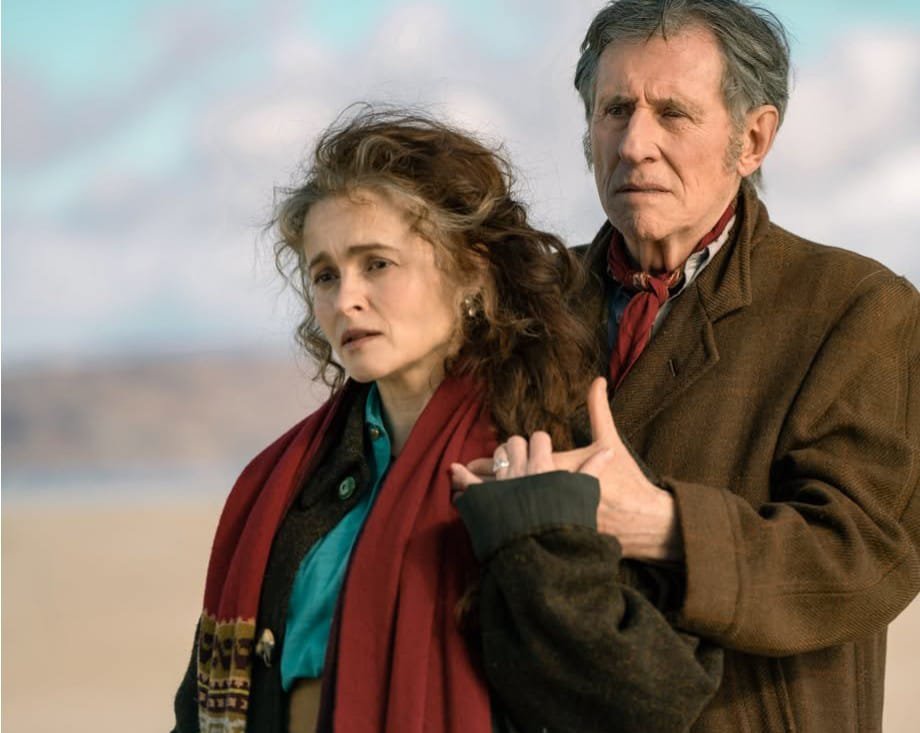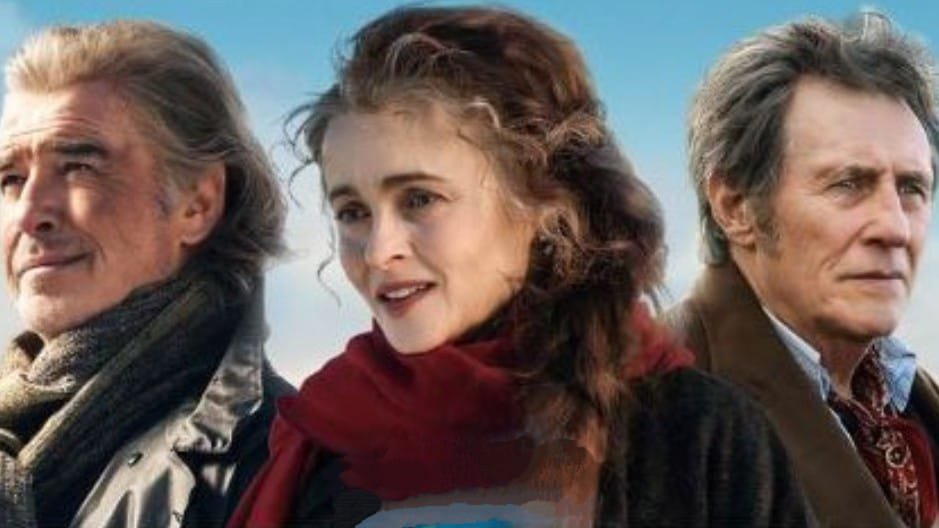Discover why “Four Letters of Love” is a poetic and beautifully acted romantic drama. Our in-depth review explores its emotional depth, stunning visuals, and unforgettable performances.
A Story That Speaks Straight to the Soul
At a time of big, loud, fast-paced filmmaking, “Four Letters of Love” is a welcome respite—quiet, soulful, serene, and incredibly poetic. Directed by Polly Steele, based on the beloved 1997 book by Niall Williams, the film is not merely a romantic drama but a contemplation of destiny, faith, and how love finds us—even in the most awkward and unanticipated of ways.
Starring Pierce Brosnan, Helena Bonham Carter, Fionn O’Shea, and Ann Skelly, all of whom provide emotionally astute performances that animate the film. Set against the dreamlike backdrop of the Irish coast, Four Letters of Love transports us on an emotionally engaging journey that is gently profound and timeless.
Plot Summary: When Destiny Speaks

As humans, we all have our own stories to tell, ones that may never intersect with others. “Four Letters of Love” centers on the intertwined stories of Nicholas Coughlan and Isabel Gore, two souls connected by destiny but separated by distance.
Nicholas (Fionn O’Shea), a free-spirited, sensitive boy with an enormously complex interior world, is raised by a mystic father (Pierce Brosnan) who is convinced that God spoke to him and told him to quit his job to pursue painting. His mother (Helena Bonham Carter) struggled to manage the family life while her husband spiraled further into spiritual obsession.
Meanwhile, on the other side of Ireland, Isabel (Ann Skelly) is raised in a household surrounded by music. When her brother—a piano prodigy—suffers a life-altering stroke, the family dynamic permanently shifts. Isabel’s own artistic sensibilities—rooted in poetry and a certain quiet spirituality—pull her inwards.
By the time Nicholas and Isabel are eventually reunited as adults, both have a history full of sorrow and losses, longing and deep needs for connection. Their love feels both predestined and fragile—an adult decision that somehow encapsulates all they have lost or hoped for.
Performances: Lovingly Real and Emotional

The heart of Four Letters of Love is in the performances. Each actor brings some sort of genuine emotion to the character, weaving a texture of feeling that reverberates through the entire film, even after the credits roll.
Fionn O’Shea as Nicholas Coughlan
Fionn O’Shea offers a career-defining performance, able to immerse himself in Nicholas with a quiet vulnerability that feels wholly natural. The wide-eyed innocence and wonder, the conflicted loyalty, the aching heart—all located in the simplest shifts in motion. He connects genuinely with the character on a deep human level—idealistic, hurt, but still open to love.
Ann Skelly as Isabel Gore
Ann Skelly embodies the grace and inner strength of Isabel. You hear a character, in danger of being overshadowed by her family’s chaos, for the first time. We believe in Isabel’s endurance, and her poetic nature, and we are not only given an enthralling character, blonde-glamorous yet believable and grounded–and romantic– a true heroine.
Pierce Brosnan and Helena Bonham Carter
As supporting roles, Brosnan and Bonham Carter are magnetic. Brosnan, far removed from his James-Bond persona, is a compellingly haunted, visionary father teetering between madness and spiritual awakening. Bonham Carter channels breathtaking motherly sorrow all the while as Nicholas’s mother.
Direction & Screenplay – Lyrical Simplicity from Polly Steele
Polly Steele is slow, gentle, and intimate in her direction. Her direction allows room and breath for the story to unfold, capturing silence, stillness, and desire, all just as significantly as the filmlets’ more emotional crescendos. She gives you a poetic construct, and allows a rhythmic-lyricism from the staging, editing, and pace–all elements you could flutter through as you would a page of a book from Niall Williams.
The produced screenplay, from Steele, very much stays true to the depth of the literary work. With Steele keeping the descriptive writing, she strikes at the heart of keeping the philosophical aspects of the novel. Rather than diluting the depth of the powerfully spiritual and spiritual loss, love affairs, love was fully embraced; never melodramatic.
Four Letters of Love has themes beyond a love story
Faith versus Reason: Nicholas’ father leaves his job to act on what he considers a literal calling. Nicholas kicking his father out speaks to the long-lasting effect religious belief has had on the family and whether it is sufficient justification for emotional abandonment.
Art as healing: Both Nicholas and Isabel find refuge and purpose through their artistic gifts. The film embraces creativity as more than self-expression, but as a space between the ordinary and divine.
The power of connection: Even before they meet, Nicholas and Isabel are aware of a larger force pulling them towards one another. They feel the bond on a cosmic level – as if the souls were destined to touch at some point, whether it took a few odd detours or not.
The Film’s Relaxed Pacing: Not for the Single, but Rewarding for Those Who Are Patient
Let’s be upfront, this is not an aggressive-paced film. “Four Letters of Love” is slow cinema at its most purposeful: the film is uninterested in propelling you to a series of plot points or emotional climaxes. Instead, it is inviting the audience to stay and be in the moment, and use the chosen feeling and reflections as they emerge.
Audience & Critical Response
So far, early indications from festival screenings have all been positive, with many claiming the film is an example of raw, emotional honesty and invokes a strong sense of literary fidelity. Critics focused on the standout performances that led the charge on our film’s description as a “rare cinematic gem.” This means it doesn’t act to pander to the audience, but genuinely and creatively trusts the audience to feel.
Audience members, who particularly desire romcoms that challenge thinking and reasoning but also emotional connection, have been left with the choice to give it a quiet standing ovation. The kind of film that lingers beyond the visuals, or shock factor, but stays with the audience emotionally.
Final Review:
★★★★½ (4.5/5)
“Four Letters of Love” is an experience, not a film. A delicate, intelligent exploration of a poetic story that trusts viewers to reflect and to remember, to ache, and to appreciate abstractions of love.
With its soulful and raw performances, poetic direction, and ability to touch on raw human themes, it will be one of the finest romantic dramas you will see for the year.
FAQs
1. Four Letters of Love is about?
Four Letters of Love tells the story of Nicholas and Isabel, two soulmates (as he said) whose lives were shaped by love, destiny, and tragedy. It is a lyrical recounting of quests of connection and intimacy. It is a film based on Niall Williams’ 1997 novel of the same name. Four Letters of Love has meaning: it is concerned with one soul and two bodies, Muses and love, destiny and the idea of art and spirit, our place in it, and why we are here as we are.
2. Is Four Letters of Love based on a book?
Yes! Four Letters of Love is based on the much-loved novel Four Letters of Love by Irish author Niall Williams, first published in 1997. The novel is renowned for its poetic prose and mysticism, and prose and themes around love.
3. Who stars in Four Letters of Love (2025)?
Four Letters of Love stars Fionn O’Shea as Nicholas Coughlan, Ann Skelly as Isabel Gore, with casting of Pierce Brosnan and Helena Bonham Carter in supporting roles. Each has been very well received in terms of depth and detail of emotional performances.
4. Who directed Four Letters of Love?
The film is directed by Polly Steele, who also adapted and wrote the screenplay. Her lyrical, emotional approach brings a tender poetic feeling to the film.
5. What Genre is Four Letters of Love?
A romantic drama with heavy elements of spirituality, mysticism, and literary introspection. It will likely find an audience reading books and more nascent works or in a contemplative, slow-burn style, always character-led.
